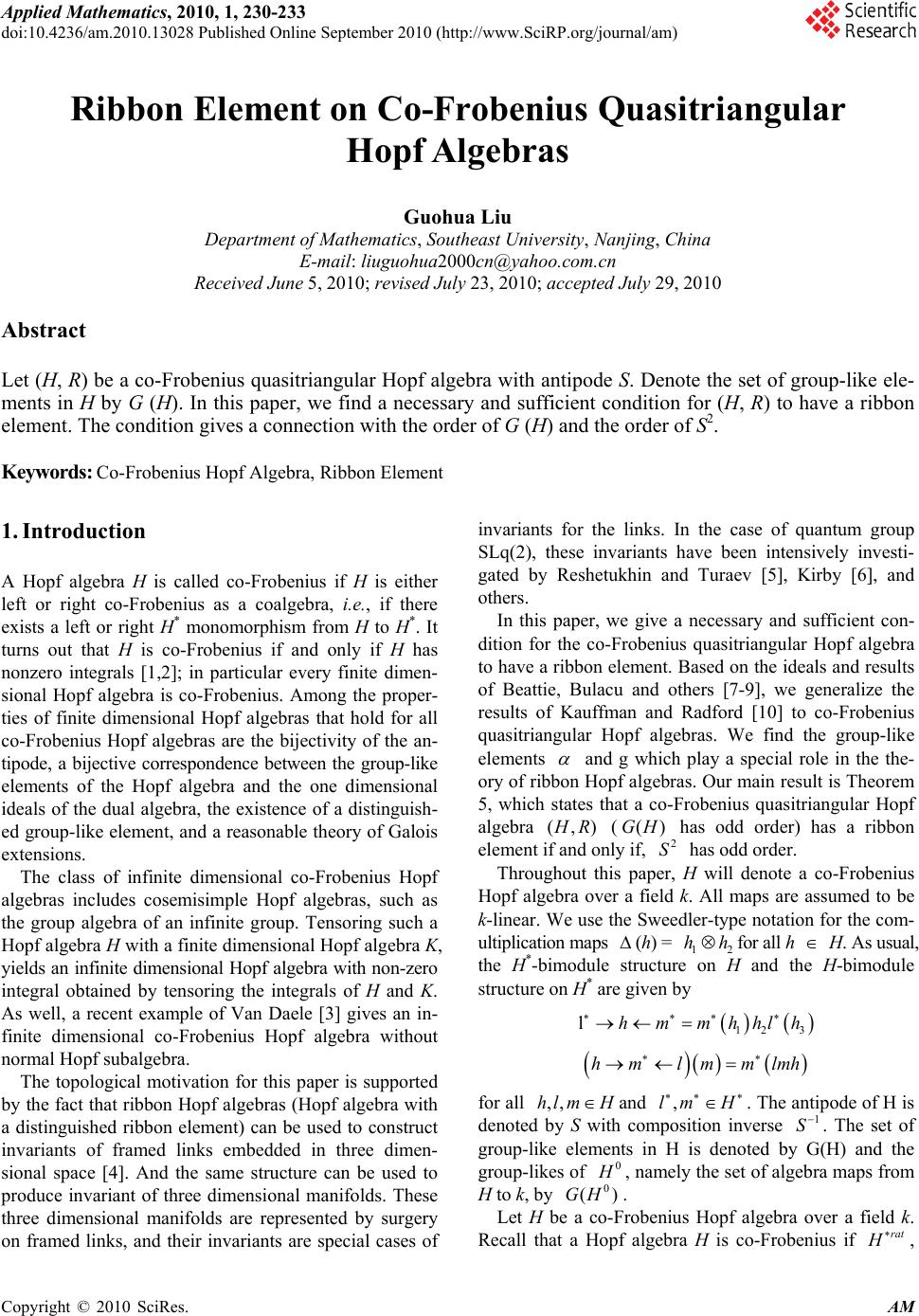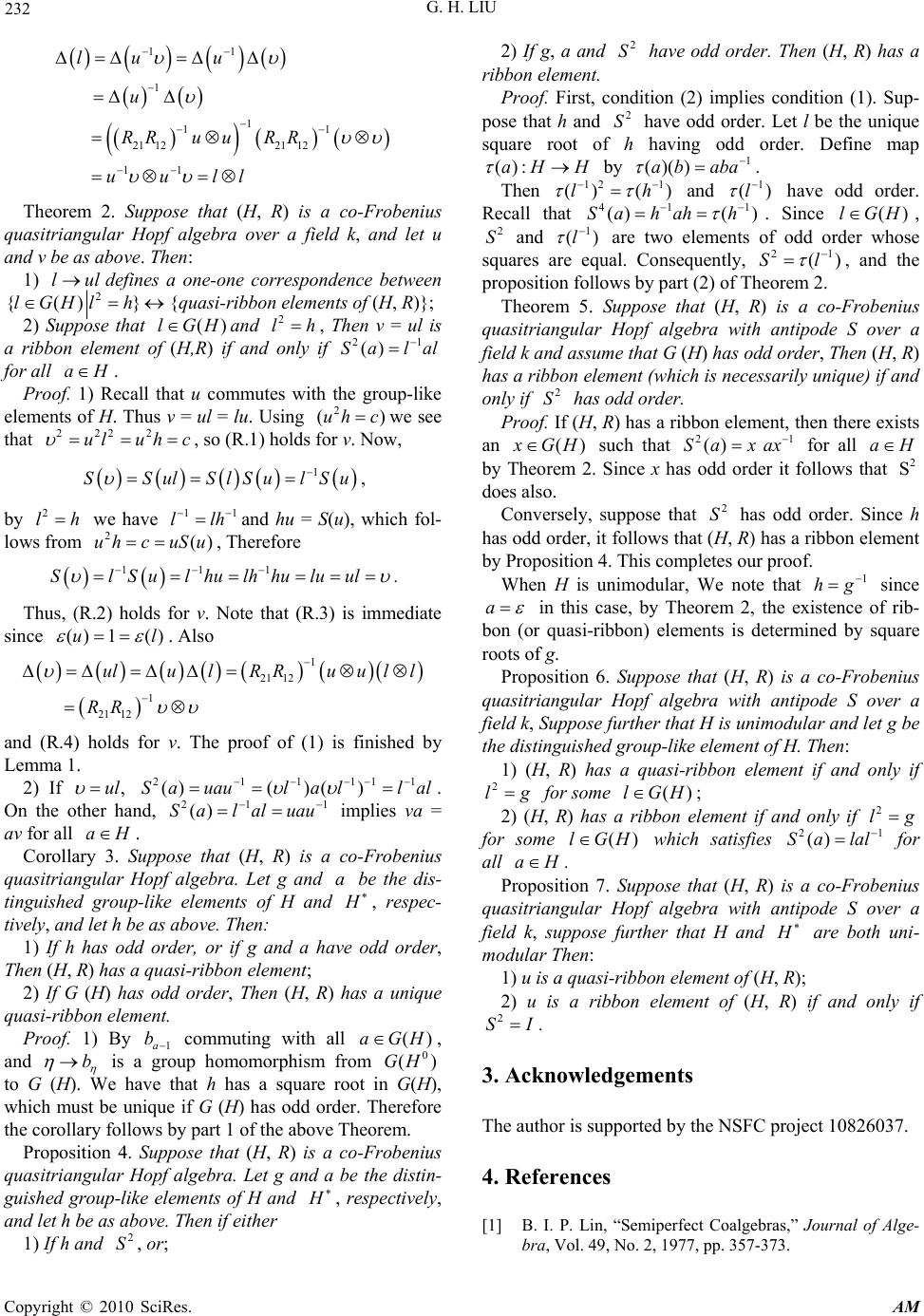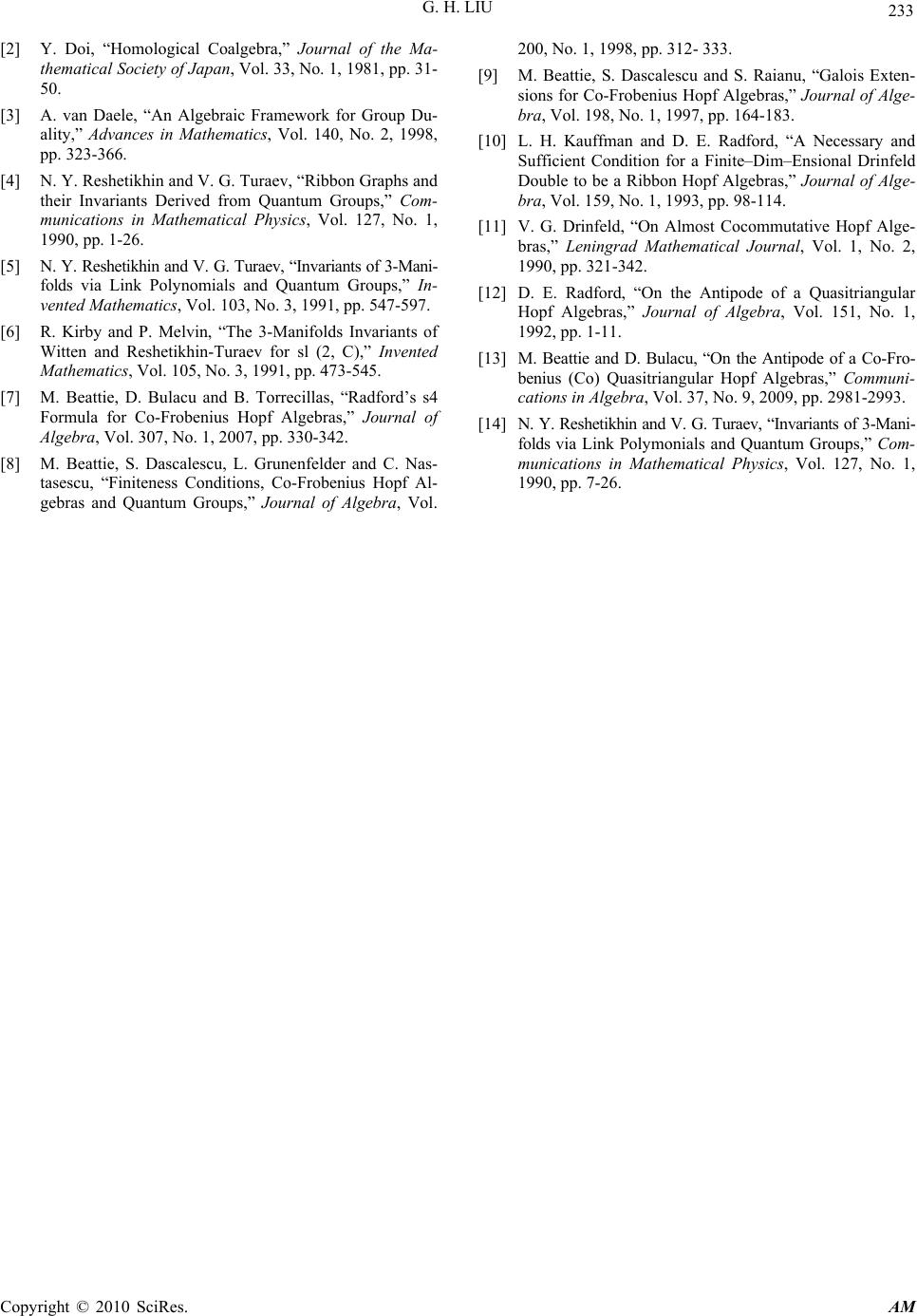Paper Menu >>
Journal Menu >>
 Applied Mathematics, 2010, 1, 230-233 doi:10.4236/am.2010.13028 Published Online September 2010 (http://www.SciRP.org/journal/am) Copyright © 2010 SciRes. AM Ribbon Element on Co-Frobenius Quasitriangular Hopf Algebras Guohua Liu Department of Mathematics, Southeast University, Nanjing, China E-mail: liuguohua2000cn@yahoo.com.cn Received June 5, 2010; revised July 23, 2010; accepted July 29, 2010 Abstract Let (H, R) be a co-Frobenius quasitriangular Hopf algebra with antipode S. Denote the set of group-like ele- ments in H by G (H). In this paper, we find a necessary and sufficient condition for (H, R) to have a ribbon element. The condition gives a connection with the order of G (H) and the order of S2. Keywords: Co-Frobenius Hopf Algebra, Ribbon Element 1. Introduction A Hopf algebra H is called co-Frobenius if H is either left or right co-Frobenius as a coalgebra, i.e., if there exists a left or right H* monomorphism from H to H*. It turns out that H is co-Frobenius if and only if H has nonzero integrals [1,2]; in particular every finite dimen- sional Hopf algebra is co-Frobenius. Among the proper- ties of finite dimensional Hopf algebras that hold for all co-Frobenius Hopf algebras are the bijectivity of the an- tipode, a bijective correspondence between the group-like elements of the Hopf algebra and the one dimensional ideals of the dual algebra, the existence of a distinguish- ed group-like element, and a reasonable theory of Galois extensions. The class of infinite dimensional co-Frobenius Hopf algebras includes cosemisimple Hopf algebras, such as the group algebra of an infinite group. Tensoring such a Hopf algebra H with a finite dimensional Hopf algebra K, yields an infinite dimensional Hopf algebra with non-zero integral obtained by tensoring the integrals of H and K. As well, a recent example of Van Daele [3] gives an in- finite dimensional co-Frobenius Hopf algebra without normal Hopf subalgebra. The topological motivation for this paper is supported by the fact that ribbon Hopf algebras (Hopf algebra with a distinguished ribbon element) can be used to construct invariants of framed links embedded in three dimen- sional space [4]. And the same structure can be used to produce invariant of three dimensional manifolds. These three dimensional manifolds are represented by surgery on framed links, and their invariants are special cases of invariants for the links. In the case of quantum group SLq(2), these invariants have been intensively investi- gated by Reshetukhin and Turaev [5], Kirby [6], and others. In this paper, we give a necessary and sufficient con- dition for the co-Frobenius quasitriangular Hopf algebra to have a ribbon element. Based on the ideals and results of Beattie, Bulacu and others [7-9], we generalize the results of Kauffman and Radford [10] to co-Frobenius quasitriangular Hopf algebras. We find the group-like elements and g which play a special role in the the- ory of ribbon Hopf algebras. Our main result is Theorem 5, which states that a co-Frobenius quasitriangular Hopf algebra (,) H R (()GH has odd order) has a ribbon element if and only if, 2 S has odd order. Throughout this paper, H will denote a co-Frobenius Hopf algebra over a field k. All maps are assumed to be k-linear. We use the Sweedler-type notation for the com- ultiplication maps (h) = 12 hhfor all h H. As usual, the H*-bimodule structure on H and the H-bimodule structure on H* are given by 12 3 lhmmhhlh hm lmmlmh for all ,,hlm H and ,lm H . The antipode of H is denoted by S with composition inverse 1 S. The set of group-like elements in H is denoted by G(H) and the group-likes of 0 H , namely the set of algebra maps from H to k, by 0 ()GH . Let H be a co-Frobenius Hopf algebra over a field k. Recall that a Hopf algebra H is co-Frobenius if rat H ,  G. H. LIU Copyright © 2010 SciRes. AM 231 the unique maximal rational submodule of H , is non- zero, or, equivalently, if the space of left or right inte- grals for H, denoted by * H l and * H r respectively, is nonzero. It was shown in [9] that H contains a distin- guished group-like element g, which is also called the modular element of H, such that for all * H l and hH: 1 12 hhhg and 21 Sg g For either a nonzero left or right integral for H in rat H , there are bijective maps from H to rat H given by ()hh and ()hh . Let denote the generalized Frobenius automor- phism of H defined in [7], that is, for * H l , is the algebra automorphism of H defined by ()hh , for all hH. Then the algebra map H is called the modular element for H in H , and 2 21 hhhS , for all hH. Recall that, for a Hopf algebra H and 1212 RRRrrH H, then (H, R) is called quasitriangular if for all hH, 121122 121122 21 12 1; 2; 3,; 41,1. cop QTRRRrR r QTRRR rrR QThRRhforall hH QTRRR R Set 21 ,().uSRRcuSu By the result of Drinfeld [11] or Radford [12], 2 S is an inner automorphism induced by u and 1 ()Su, i.e. 21 ()Sa uau , and 21 () ()()SaSu aSu , for all aH. c is called the Casimir element of (H, R), and 21 ()Sa uau implies that c is in the center of H. If (H, R) is quasitriangular, Beattie and Bulauc [13] introduced two group homomorphisms from 0 ()GH to G (H) given by 1212 1 121 :,:aRRbSRR RR They showed that ,()ab GH and 1 ab () ()GH ZH . Now set 11 11 (), g bbhbg . By [13], we have11 () ()uS uSuugg . By [12] and [13], we have (g, denote the modular elements), 2 cuh. Since c is central, 212 () ,Sauaucu h , implies that 2 42121 2 21 11 Sa uSauuau uacuh ah We say that H is a quasi-ribbon element of (H, R) if the following conditions are satisfied: 2 1 21 12 .1 ; .2 ; .3 1; .4 , Rc RS R RRR Drinfeld observed that u satisfies the last condition. A quasi-ribbon element in the center of H is called a ribbon element, and in this case (H, R, v) is called a ribbon Hopf algebra [14]. The reader is referred to [14] for a detailed discussion of ribbon Hopf algebras and their relationship to links and three-manifolds. 2. Ribbon Hopf Algebra Let (H, R) be a finite dimensional quasitriangular Hopf algebra. In [10], the authors found a necessary and suffi- cient condition for the existence of ribbon elements on (H, R). The purpose of this section is to generalize their result to co-Frobenius quasitriangular Hopf algebras. We find that most of the results in [10] also hold for co- Frobenius quasitriangular Hopf algebras. Lemma 1. Suppose that (H, R) is a co-Frobenius qua- sitriangular Hopf algebra over a field k, H contains a distinguished group-like element g and that v H is a quasi-ribbon element of H. Let 1121 11 ,, g bbhbguSRR and set 1 lu . Then: 1) 2;lh 2) ().lGH Proof. 1) By (R.2) (S(v) = v), we have 2()S . Thus u and v commute by 21 ()Suau for all aH . By 2 (.1)Rc and 2 cuh we have 22 uh . Thus 2 lh . 2)  G. H. LIU Copyright © 2010 SciRes. AM 232 11 1 1 11 21 1221 12 11 luu u RRu uRR uull Theorem 2. Suppose that (H, R) is a co-Frobenius quasitriangular Hopf algebra over a field k, and let u and v be as above. Then: 1) luldefines a one-one correspondence between 2 {() }lGHl h{quasi-ribbon elements of (H, R)}; 2) Suppose that ()lGHand 2 lh, Then v = ul is a ribbon element of (H,R) if and only if 21 ()Salal for all aH. Proof. 1) Recall that u commutes with the group-like elements of H. Thus v = ul = lu. Using 2 ()uh cwe see that 2222 uluh c , so (R.1) holds for v. Now, 1 SSulSlSulSu , by 2 lh we have 11 llh and hu = S(u), which fol- lows from 2()uh c uSu , Therefore 111 SlSu lhulhhuluul . Thus, (R.2) holds for v. Note that (R.3) is immediate since () 1()ul . Also 1 21 12 1 21 12 ululR Ruull RR and (R.4) holds for v. The proof of (1) is finished by Lemma 1. 2) If 211111 ,() ()()ulSauaulall al . On the other hand, 211 ()Salal uau implies va = av for all aH. Corollary 3. Suppose that (H, R) is a co-Frobenius quasitriangular Hopf algebra. Let g and a be the dis- tinguished group-like elements of H and H , respec- tively, and let h be as above. Then: 1) If h has odd order, or if g and a have odd order, Then (H, R) has a quasi-ribbon element; 2) If G (H) has odd order, Then (H, R) has a unique quasi-ribbon element. Proof. 1) By 1a b commuting with all ()aGH , and b is a group homomorphism from 0 ()GH to G (H). We have that h has a square root in G(H), which must be unique if G (H) has odd order. Therefore the corollary follows by part 1 of the above Theorem. Proposition 4. Suppose that (H, R) is a co-Frobenius quasitriangular Hopf algebra. Let g and a be the distin- guished group-like elements of H and H , respectively, and let h be as above. Then if either 1) If h and 2 S, or; 2) If g, a and 2 S have odd order. Then (H, R) has a ribbon element. Proof. First, condition (2) implies condition (1). Sup- pose that h and 2 S have odd order. Let l be the unique square root of h having odd order. Define map ():aH H by 1 ()()a baba . Then 12 1 ()( )lh and 1 ()l have odd order. Recall that 41 1 ()( )Sa hahh . Since ()lGH , 2 S and 1 ()l are two elements of odd order whose squares are equal. Consequently, 21 ()Sl , and the proposition follows by part (2) of Theorem 2. Theorem 5. Suppose that (H, R) is a co-Frobenius quasitriangular Hopf algebra with antipode S over a field k and assume that G (H) has odd order, Then (H, R) has a ribbon element (which is necessarily unique) if and only if 2 S has odd order. Proof. If (H, R) has a ribbon element, then there exists an () x GH such that 21 ()Sa xax for all aH by Theorem 2. Since x has odd order it follows that 2 S does also. Conversely, suppose that 2 S has odd order. Since h has odd order, it follows that (H, R) has a ribbon element by Proposition 4. This completes our proof. When H is unimodular, We note that 1 hg since a in this case, by Theorem 2, the existence of rib- bon (or quasi-ribbon) elements is determined by square roots of g. Proposition 6. Suppose that (H, R) is a co-Frobenius quasitriangular Hopf algebra with antipode S over a field k, Suppose further that H is unimodular and let g be the distinguished group-like element of H. Then: 1) (H, R) has a quasi-ribbon element if and only if 2 lg for some ()lGH ; 2) (H, R) has a ribbon element if and only if 2 lg for some ()lGH which satisfies 21 ()Sa lal for all aH . Proposition 7. Suppose that (H, R) is a co-Frobenius quasitriangular Hopf algebra with antipode S over a field k, suppose further that H and H are both uni- modular Then: 1) u is a quasi-ribbon element of (H, R); 2) u is a ribbon element of (H, R) if and only if 2 SI . 3. Acknowledgements The author is supported by the NSFC project 10826037. 4. References [1] B. I. P. Lin, “Semiperfect Coalgebras,” Journal of Alge- bra, Vol. 49, No. 2, 1977, pp. 357-373.  G. H. LIU Copyright © 2010 SciRes. AM 233 [2] Y. Doi, “Homological Coalgebra,” Journal of the Ma- thematical Society of Japan, Vol. 33, No. 1, 1981, pp. 31- 50. [3] A. van Daele, “An Algebraic Framework for Group Du- ality,” Advances in Mathematics, Vol. 140, No. 2, 1998, pp. 323-366. [4] N. Y. Reshetikhin and V. G. Turaev, “Ribbon Graphs and their Invariants Derived from Quantum Groups,” Com- munications in Mathematical Physics, Vol. 127, No. 1, 1990, pp. 1-26. [5] N. Y. Reshetikhin and V. G. Turaev, “Invariants of 3-Mani- folds via Link Polynomials and Quantum Groups,” In- vented Mathematics, Vol. 103, No. 3, 1991, pp. 547-597. [6] R. Kirby and P. Melvin, “The 3-Manifolds Invariants of Witten and Reshetikhin-Turaev for sl (2, C),” Invented Mathematics, Vol. 105, No. 3, 1991, pp. 473-545. [7] M. Beattie, D. Bulacu and B. Torrecillas, “Radford’s s4 Formula for Co-Frobenius Hopf Algebras,” Journal of Algebra, Vol. 307, No. 1, 2007, pp. 330-342. [8] M. Beattie, S. Dascalescu, L. Grunenfelder and C. Nas- tasescu, “Finiteness Conditions, Co-Frobenius Hopf Al- gebras and Quantum Groups,” Journal of Algebra, Vol. 200, No. 1, 1998, pp. 312- 333. [9] M. Beattie, S. Dascalescu and S. Raianu, “Galois Exten- sions for Co-Frobenius Hopf Algebras,” Journal of Alge- bra, Vol. 198, No. 1, 1997, pp. 164-183. [10] L. H. Kauffman and D. E. Radford, “A Necessary and Sufficient Condition for a Finite–Dim–Ensional Drinfeld Double to be a Ribbon Hopf Algebras,” Journal of Alge- bra, Vol. 159, No. 1, 1993, pp. 98-114. [11] V. G. Drinfeld, “On Almost Cocommutative Hopf Alge- bras,” Leningrad Mathematical Journal, Vol. 1, No. 2, 1990, pp. 321-342. [12] D. E. Radford, “On the Antipode of a Quasitriangular Hopf Algebras,” Journal of Algebra, Vol. 151, No. 1, 1992, pp. 1-11. [13] M. Beattie and D. Bulacu, “On the Antipode of a Co-Fro- benius (Co) Quasitriangular Hopf Algebras,” Communi- cations in Algebra, Vol. 37, No. 9, 2009, pp. 2981-2993. [14] N. Y. Reshetikhin and V. G. Turaev, “Invariants of 3-Mani- folds via Link Polymonials and Quantum Groups,” Com- munications in Mathematical Physics, Vol. 127, No. 1, 1990, pp. 7-26. |

